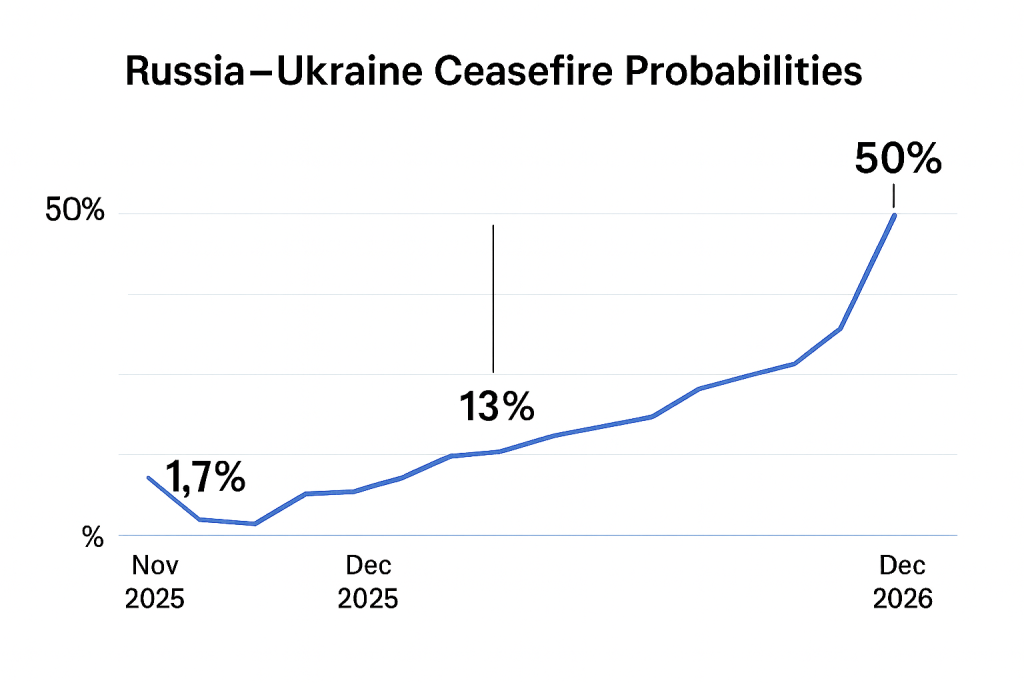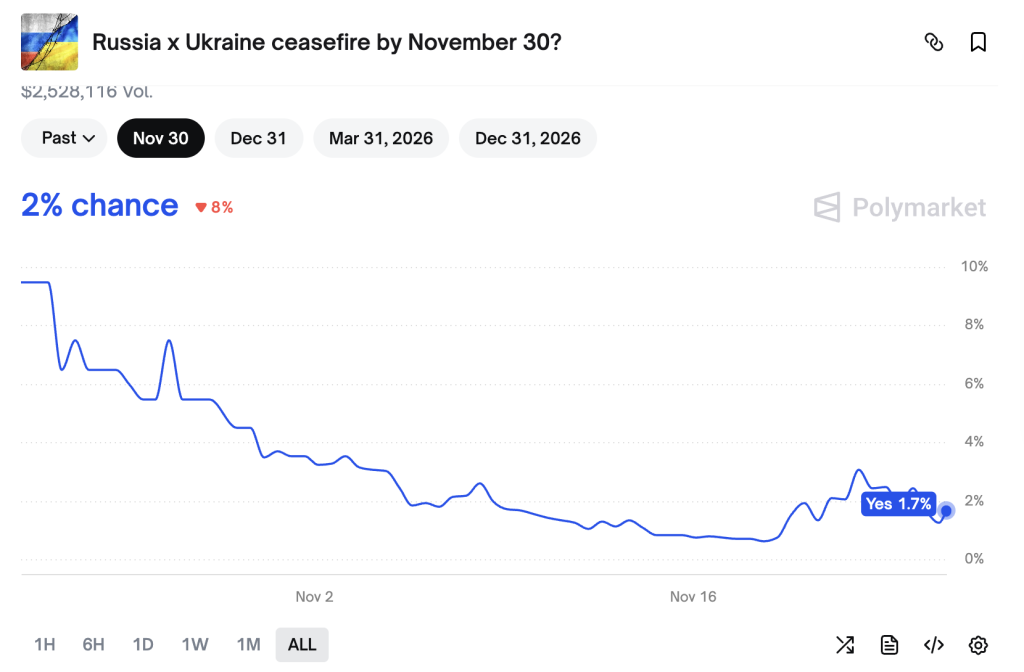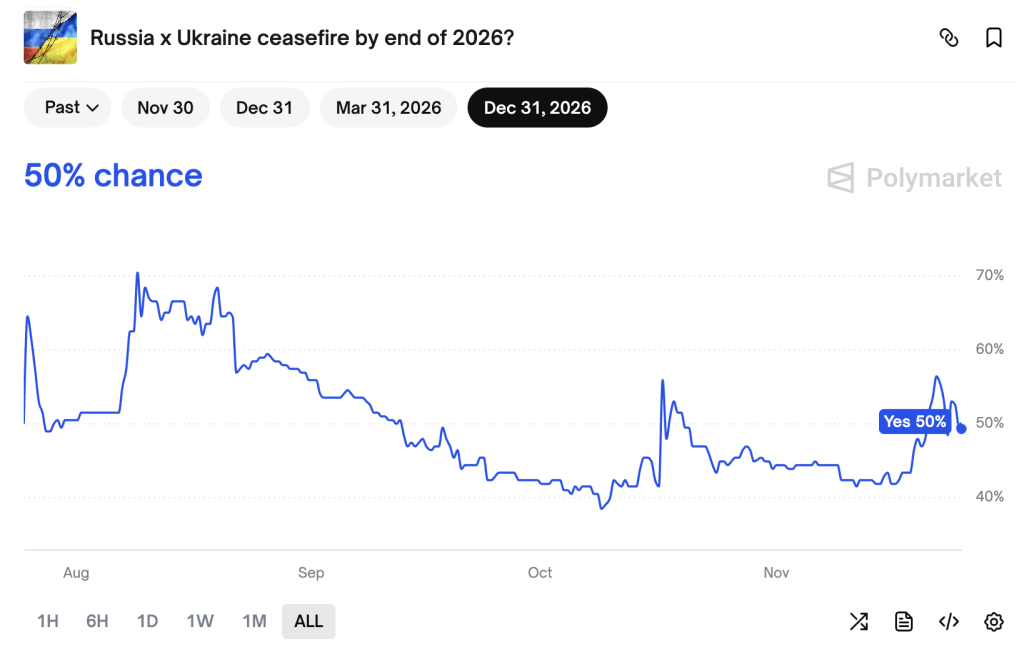Prediction markets across Polymarket now show diverging expectations on when — or whether — Russia and Ukraine will formalize a ceasefire, according to agamble.com’s analytics. Near-term scenarios carry extremely low probabilities. Traders give a deal by November 30 a 1.7% chance and a 13% chance by December 31, 2025. However, the longer time frame tells a different story. The contract that expires on December 31, 2026, is trading at 50%, reflecting significantly higher confidence in a medium-term diplomatic breakthrough.

What the Ceasefire Markets Are Actually Pricing In
The market tracks the probability of an official, mutually agreed ceasefire between Russia and Ukraine. To qualify under Polymarket’s resolution rules, both governments must publicly announce and mutually confirm a halt in military engagement — and specify a date on which hostilities stop.
Political frameworks or draft proposals do not count unless they include a dated commitment to cease fighting. Humanitarian pauses are excluded. If a ceasefire agreement is reached any time before December 31, 2026, 11:59 PM ET, the contract resolves “Yes,” even if the ceasefire takes effect later.
Resolution is based on official statements, but broad confirmation across credible media can also serve as evidence.
Inside the Diplomatic Push That Shifted Expectations
The geopolitical backdrop shifted sharply after a week of intensive talks:
- Geneva negotiations between U.S. and Ukrainian officials resulted in a revised, condensed peace framework — reduced from 28 to 19 points.
- Abu Dhabi meetings brought U.S. Army Secretary Dan Driscoll together with Russian officials, with President Vladimir Putin’s approval.
- Both Kyiv and Moscow signaled cautious openness: Ukraine stressed that “proper considerations” were added to the new draft, and Putin said the U.S. proposal “could form the basis” for a settlement.
European sources told Bloomberg that one of the most contentious provisions — repurposing $100 billion in frozen Russian assets — was removed from the latest draft. The most difficult questions now fall directly to Zelensky, Trump, and Putin, who must personally approve any final agreement. NATO-related guarantees and territorial arrangements remain the primary sticking points.
Thanksgiving Deadline Now Looks Increasingly Unrealistic
By November 30, 2025 — 1.7%
With Thanksgiving days away, traders overwhelmingly reject the possibility of an immediate breakthrough. The market’s chart shows a steady decline throughout November despite successive rounds of diplomacy. Territorial negotiations, leadership-level approval, and structural revisions to the agreement leave too little time for a formal announcement.

Community sentiment reflects this skepticism. One trader wrote simply: “Neither Trump nor Putin ever read that plan.”
By December 31, 2025 — 13%
The year-end outlook for 2025 remains weak but not negligible. Prices have dropped more than 50% from earlier highs, suggesting that traders once viewed a 2025 deal as more plausible but have since recalibrated as negotiations slowed.

The bottleneck appears structural. Ukraine wants firmer security guarantees; Russia wants clearer territorial concessions; and the U.S. proposal still requires leader-level negotiation. Markets now treat 2025 as too compressed for a mutually agreed, dated ceasefire.
By December 31, 2026 — 50%
The 2026 contract is where trader expectations shift dramatically. At 50%, this is effectively a coin-flip — the highest probability the market assigns to any timeline.

Why Markets View 2026 as a Turning Point, and Where the Optimism Comes From
Traders may interpret recent diplomacy as the early stage of a multi-step settlement process. A 2026 timeline allows room for:
- Additional revisions to the draft framework
- More rounds of U.S.–Russia–Ukraine trilateral diplomacy
- European involvement as consultations accelerate
- Political incentives for the Trump administration to deliver a substantive foreign-policy achievement
- political incentives for Trump’s administration to deliver a foreign-policy win
Market sentiment suggests that if a deal is possible at all, it is far more likely to materialize around Thanksgiving 2026 than at any point in 2025.
Polymarket comments echo this mood. One holder wrote: “Diplomacy has been reinvigorated — and this is good. We expect the outcome to deliver the right steps.” Another simply called the “Yes” side “free money.”
Where the Forecast Stands After the Geneva and Abu Dhabi Talks
Prediction markets remain clear on the near-term outcomes: a ceasefire in 2025 appears highly unlikely, with odds no higher than 13%. But the medium-term expectation has shifted. At 50%, traders now see 2026 as the first genuinely plausible window for an official, mutually agreed Russia–Ukraine ceasefire.
Whether the momentum seen in Geneva and Abu Dhabi carries forward — and whether Zelensky, Trump, and Putin can converge on the remaining unresolved terms — will determine how long that optimism lasts.
Would you bet?
Follow the “Russia x Ukraine ceasefire in 2025?” prediction market here:
https://polymarket.com/event/russia-x-ukraine-ceasefire-in-2025




